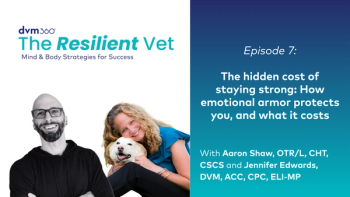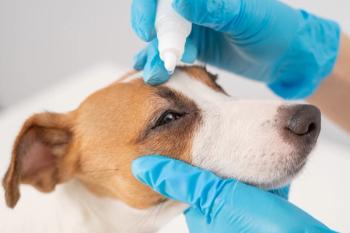
Semen collection and shipment (Proceedings)
A guide to proper semen collection and shipment.
- Factors affecting sperm quality
o Temperature
o Light
o Water
o Blood
o Urine
o Rubber on syringe plunger
o Detergent
o Debris
o Stuff
- Semen is ejaculated in 3 fractions
o First fraction-pre-sperm (prostate)-clear and acellular
o Sperm rich fraction (tail of epididymis)-opalescent in color
o Prostatic fraction-large volume of clear fluid in a normal dog
- Raw semen
o Needs to be used quickly for artificial insemination
o Raw semen more sensitive to light and temperature than extended semen
o Keep it warm
o If used for several females need to determine if insemination volume will be adequate
- Extended semen
o Extenders
• Prolong the viability and fertilizing capability
• Protect against cold shock
o Antibiotics
• Inhibit bacterial growth
o Allows maximum utilization of the ejaculate by increasing volume without reducing sperm viability
o Have the proper osmotic pressure and balance of ingredients
o Contains buffers, energy source, antibiotics and cryoprotectant
o When handling extended semen, take some care as with raw semen
o Types of extender
• Milk base
• Egg yolk base
o Preparation of extenders does not require expensive equipment and extenders can be stored in frozen aliquots (commercial extenders better!!!)
o Has to be warm before added to sperm
o Volume added to the ejaculate will depend upon volume of the ejaculate and sperm concentration
o Dilutions are at least 1:1 (one part semen to one part extender)
o Extended semen should be used within hours if kept at room temperature
o Extended semen may be cooled or frozen for transport or storage
- Cooled semen
o For transport of short-term storage
o Lowering the temperature reduces metabolic activity of the sperm
o Extended semen is cooled at a slow rate of 5-10°C
o Cooled semen good for 24 hours (?)
o Avoid temperature changes once semen is cooled
o Semen has to be used within 24 hours
o Cooled semen may or may not need to be at body temperature prior to insemination (ex. Mares inseminated with semen still cold, dogs inseminated with semen at 35°C)
- Frozen semen
o Long term storage-1000 years
o Extenders used for frozen semen need to have a cryoprotectant (glycerol)
o Volume of extender used for frozen semen is usually smaller than volume used for cooled semen
o Semen frozen in pellets, ampules or straws
o Rapid freeze, rapid thaw (follow instructions)
o Thawing method will depend upon freezing process or type of extended used (read instructions that accompany the shipment)
o Semen kept at -196°C
o Semen should be used immediately after thawing
o Semen quality is decreased after the freezing and thawing process (vary according to different animals and between species)
o Since some sperm are killed during the freezing and thawing it may be required to increase the number of sperm per insemination
- Collection procedure
o Best accomplished in the presence of a bitch in estrus
• Some males will ejaculate in the presence of a non-estrus bitch but may not produce as many sperm
o Males may be trained to ejaculate without the presence of any other dogs but sperm quantity is usually less
• Primarily important when males are subfertile or semen is to be frozen and the maximal number of sperm is desired
o Collection area
• Should be quiet and free of as many distractions as possible
• If the male has been used previously, a rug or mat from the breeding area may be of value in getting the male interested in the procedure
o Examination of the male should occur following the collection procedure to ensure he does not become disturbed or disinterested
o As the male is introduced to the female and/or breeding area, the pens should be palpated to determine the amount of erection
o It is important to prolapse the penis from the prepuce before the penis becomes too erect
o If the bulb of the penis becomes too large to prolapse the penis, the male should be removed from the room until the erection has subsided.
o Once the penis has been prolapsed from the prepuce, place the forefinger and thumb firmly and grasp the penis proximal to the bulb and apply alternating pressure to the penis
• This pressure should induce urethral pulsations to begin, which can easily be palpated
- Fractions of the ejaculate
o First portion of the ejaculate is clear seminal plasma and has the purpose of flushing the urethra prior to the sperm rich fraction being ejaculated
• The clear seminal plasma is usually ejaculated while the male is very actively thrusting and moving about
o Second fraction is the sperm rich fraction
• It is usually present when the male is quieter and the thrusting and major movements have stopped
• Many times it is close to the beginning of the sperm rich fraction when the male steps over the hand and arm and is content to ejaculate with the penis directed posteriorly
o Third fraction is the prostatic fluid
• Should not be collected unless artificial insemination is to occur immediately and then only in small amounts
- Collection supplies
o Latex rubber collecting cone with graduated tube attached
o The latex rubber is placed over the exposed penis and held in place until the ejaculate becomes clear as is observable on the side of the glass tube
o Latex rubber has been demonstrated to be spermicidal but the contact time with sperm is so short that there is no detrimental effect
o Care should be taken in the use of a small quantity of a sterile non-spermicidal lubricant
• Priority-Care© is currently the author's choice of lubricant but other acceptable ones are available
Newsletter
From exam room tips to practice management insights, get trusted veterinary news delivered straight to your inbox—subscribe to dvm360.




